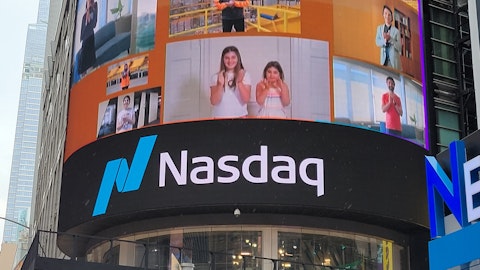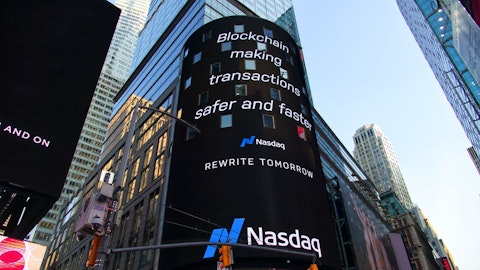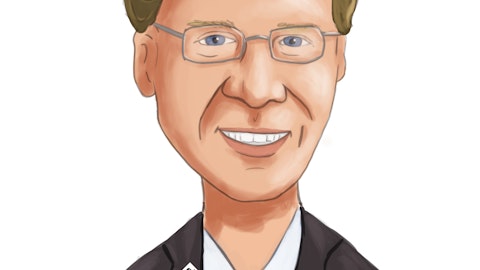Gautam Sawant: Good morning, Adena and Ann. I wanted to just spend a second on Puro.earth and the long-term opportunity there. I know Puro.earth presented at COP 27 and the trading certificates increased 250% in 2022. Can you talk about the potential earnings contribution from this business in the future? And is there an opportunity to sell Puro.earth directly to your corporate clients that are across the U.S. and Nordic businesses?
Adena Friedman: Sure. Yes. Actually, we do. So what — I love talking about Puro.earth. So just as a reminder, Puro.earth a carbon removal marketplace where we have a minority position in partnership with a company called Fortum in Finland. And we are really excited about the opportunity that Pure Earth provides to us and, frankly, to our clients. So we do already tap our corporate clients as clients. So they come in directly and buy carbon removal credits through the Puro.earth platform, and we leverage our corporate relationships to really continue to grow the demand for those credits. I think that what’s holding that market back today, and it’s very small, so I just want to enforce off on everyone that, that is a small business today.
It did grow, as you said, actually, I think it was like 250% to 300% year-over-year but from a tiny base, it sits in our Market Platforms business. It supports our ESG strategy and that mega trend. But what’s really holding that platform are all — that whole marketplace back is supply. So we are really focused on high-quality industrial carbon removals. We do diligence on every supplier we put on the platform. We have — we work with an advisory committee to determine which scientific methods we’re willing even to put on the platform. We’re very, very discerning in how we bring supply onto the platform. And given the fact that it’s still a pretty nascent industry, we’re really hamstrung by small supply today. So over the next three to five years, we actually expect a lot of investment to come into the carbon renewal space.
We think that will really bolster supply. We’re replatforming Puro.earth to have a really advanced blockchain based registry that we can then leverage across multiple trading venues. And we’re working with some market makers to help create — they’re going to buy up from removals and start to create a secondary market, so that we can also have trading activity start to develop on the platform. But I want to say this. I think Puro.earth is kind of like a 5 to 10-year strategy. It’s a very small investment for us as of right now. It’s a small but mighty team. But we are really, really excited about what it can become, but just recognize it’s a long-term strategy.
Operator: And I show our next question comes from the line of Alexander Blostein from Goldman Sachs. Please go ahead.
Alexander Blostein: Good morning. Thanks for the question. I was hoping we could dig into some of the interplays in the kind of legacy listings business and the Corporate Solutions business. I guess, on the one hand, I was curious if you could help frame the revenues that could be at risk from stocks delisting over the course of this year, and then on the flip side, opportunities you guys might see from some of the discounts on the Corporate Solutions services that you provided to IPOs that listed over the last couple of years, those coming off and the probability of them starting to pay for service?
Adena Friedman: Great. Yes. Thanks, Alex. I mean the SPAC revenue represents just over about 1% of total revenue for Nasdaq. So it’s a small part of our revenue stream. We are seeing SPAC combined, but we’re also seeing a number of SPAC decide to provide the money back to their shareholders. So it’s a small part of our revenue. And — but we’re — but we also recognize that the environment has changed a lot for SPACs, and so we would anticipate some reduction in revenue coming from the back of SPAC ultimately not finding combinations. So I think that’s something that will probably have more of an effect in 2024 than in 2023, but it’s something we’re watching pretty closely. But as I said, just to size it, it’s a little more than just 1% of the revenue.
I think with regard to Corporate Services and Solutions, which is our IR and our ESG solutions to support corporates, you are right. We have a lot of clients who come on to our platform. We’ve been supporting them through the IPO package for the last two years. And so as we get particularly into 2024, we’re going to see the opportunity for us to turn them in and convert them into paying clients. And so that is obviously — that part of our outlook for that business is how we convert those clients to paying customers. We’ve also upsold those clients even during the IPO package period where we might sell them into some of our ESG packaged solutions and into a deeper set of IR solutions. So we do have them some of them as paying clients now. And I think that obviously, even bolsters our view that they’ll continue to want to use our services beyond the IPO period.
But I just want to say, I think that’s more of a ’24 opportunity than ’23, but we’re very optimistic about that. We have strong retention of clients as we convert them.
Operator: And I show our last question comes from the line of Kyle Voigt from KBW. Please go ahead.
Kyle Voigt: Good morning. Maybe a question on the BEC migration from your on-premise solution to your cloud-based platform. Could you just remind us of the revenue and margin impact for Nasdaq from this type of on-premise to cloud migration? I’m just trying to put some numbers around the impact so we have a better understanding of kind of the larger opportunity if we see more similar type announcements over the coming year or two?
Adena Friedman: Yes. I think that we’ll probably need to come back to you to give you a little bit more of that view. I can’t sit there and use one client and extrapolate it to the whole business. But when we do sign a client on to more of a SaaS-based market tech contract, there are two benefits. One is just it becomes an annualized recurring revenue as opposed to an implementation revenue, which has much lower margins, followed by a service and maintenance and license agreement which has a higher margin. So you have like more steady revenue and a more steady margin throughout the length of the contract. But I don’t think we’ve given you a view yet into like what’s the margin differential. And so I kind of feel like we probably need to come back and give a little bit more of an insight into that specifically as we gain more traction in getting our clients to sign on to cloud-based, particularly cloud-based solutions.
So let’s come back to you on that, but I just don’t want to give you kind of a wrong answer right now.
Operator: Thank you. That concludes our Q&A session. At this time, I would like to turn the call back over to Adena Friedman for closing remarks.
Adena Friedman: Great. Thank you very much. Well, as we conclude today’s call, I want to reiterate that our leadership team remains very focused on executing our strategy to deliver for all of our stakeholders, and we look forward to continued discussions throughout the year on the progress we aim to make against our strategic priorities. So thank you very much, and have a great day.
Operator: Thank you. And this concludes today’s conference call. Thank you for participating. You may now disconnect.
Follow Nasdaq Inc. (NASDAQ:NDAQ)
Follow Nasdaq Inc. (NASDAQ:NDAQ)
Receive real-time insider trading and news alerts




